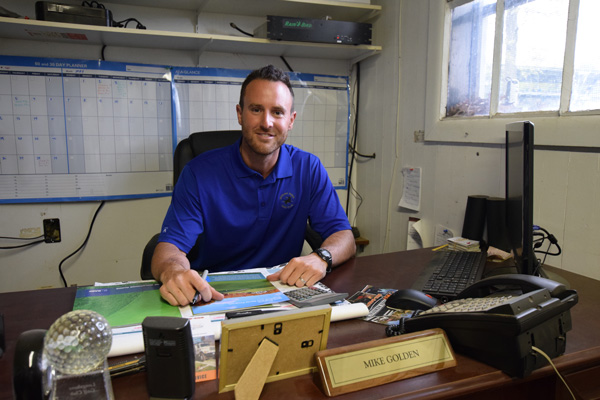A Peek Behind the Curtain: The Life of a Golf Course Superintendent (Mike Golden: Sterling Farms GC, Stanford, CT)
One of our goals here at Scratch Sundays is to showcase many different facets of the golf industry and to give our readers a peak behind the curtain with regards to golf course operations. With that in mind, I reached out to a good friend of mine, Mike Golden, who is a golf course superintendent. Mike is 35 years old, but has accomplished quite a lot in his 17 years as a superintendent. Most recently, Mike was one of six finalists for the TurfNet Superintendent of the Year, while also managing to get his course (Sterling Farms GC, Stamford, CT) a grant from BASF that included close to $30,000 in free fungicide. I have included a transcript of the interview below, and I hope you all find it as fascinating as I did.
BJ VanderWoude: Hey Mike, thanks for taking the time to sit down with me and allowing our readers to get a behind the scenes look at the life of a golf course Superintendent. Let’s start from the beginning of your career. Where did you go to college, and what did you study?
Mike Golden: Thanks for having me, BJ. I went to Delhi College in upstate New York, and I studied Turf Grass Management. Throughout college, I was lucky enough to be hired for several different internships.
BJ VanderWoude: Where did you attend your internships in college?
Mike Golden: My first internship was at Canoe Brook Country Club in Summit, NJ. Canoe Brook has two 18 hole championship golf courses. The North Course opened for play in 1901 and much later on Rees Jones was responsible for the redesign. The South Course opened for play in 1924 and was designed by the famous architectural firm of Colt, Alison and MacKenzie. Allister MacKenzie is famous for designing Augusta National as well as many other classic golf courses. I then moved on to Twin Brooks Golf Course in Hyannis, MA. My last internship was at Metedeconk National Golf Club, where I worked for two summers. Metedeconk is a 27 hole masterpiece created by Robert Trent Jones Sr. and boasts one of the best practice facilities on the East Coast. This internship led to me being offered the job of assistant superintendent after I graduated college.
BJ VanderWoude: From the sounds of it, Metedeconk is a fantastic place to land an assistant superintendent job right out of college. How did working at such a high scale country club influence your career moving forward?
Mike Golden: Well first off, Metedeconk is a 27 hole course and the membership take pride in the course being very well conditioned, so the maintenance side is a large scale operation. The maintenance team consisted of 40 full time guys, which is much larger than any of the other courses I’ve worked at. As a reference point, my last two crews were 12 and 14 men.
BJ VanderWoude: You have worked at a lot of different golf courses, both public and private. Where did you go after leaving Metedeconk, and what was the transition like?
Mike Golden: After leaving Metedeconk, I was the assistant superintendent at Century Country Club in Purchase, NY. I was there for four years before moving on to Edgewood Country Club in Riverdale, NJ, which was also a 27 hole golf course. Edgewood was interesting because for a 27 hole golf course, it did not see nearly the amount of rounds played as other private clubs of its size. After Edgewood, I moved to The Stanwich Club in Greenwich, CT. Stanwich was designed by William and David Gordon, a father/son design team that had built courses for Donald Ross and Devereux Emmet. They also played a big role in the revisions of two of the most classic golf courses in America, Shinnecock Hills (NY) and The Country Club (MA). Stanwich was ranked as the #1 golf course in Connecticut by Golf Digest for 2017-18, and also won Golf Digest’s “Best New Remodel” in 2006 for the work done by Tom Fazio. Working at such an illustrious club for two years gave me the knowledge and exposure necessary to snag my first head superintendent position, which I accepted at Longshore Golf Club in Westport, CT. Although I was only at Longshore for one year, I spearheaded a major bunker renovation project that dramatically improved the aesthetic value of the course. The success of this project played a role in me being offered the head superintendent position at Sterling Farms Golf Course in Stamford, CT, where I currently reside. Longshore and Sterling Farms are both municipal courses, however Sterling Farms is by far the most populated golf course in the area, doing in excess of 50,000 rounds per year. I wanted to continue to challenge myself as a superintendent, and Sterling Farms was a great course to do just that.
BJ VanderWoude: As someone who follows Mike around to play whatever golf courses he is working at, I can attest to his skillful hand as a superintendent. You mentioned the bunker renovation at Longshore, what are some of the other big projects you have been a part of throughout your career?
Mike Golden: The bunker renovation project at Longshore was one of several I have been involved in, and that is a project that the workers can take pride in as aesthetically it makes such a big difference when you see well maintained, sharp edges to the bunkers. I have participated in green expansion projects, large scale tree removal, native area renovations and large scale drainage projects. In fact, we are currently preparing to add drainage to all 18 greens in the off-season at Sterling Farms.
BJ VanderWoude: What type of budget do you need for a drainage project that includes all 18 greens?
Mike Golden: Luckily the drainage project is a capital expenditure, and is not directly related to our course budget, as it will run in the neighborhood of $250,000.
BJ VanderWoude: Speaking of budgets, you have worked at both private and public golf courses. What is the difference in budgets, and how does that correlate to course conditions?
Mike Golden: Generally speaking, private clubs will usually have roughly 2x-3x the budget that a public course has, but that also depends on where each course is located and how popular the public courses are in the area. With that said, the public courses will usually do 2x-3x the amount of rounds as the private club over the course of a year. That is the challenging part as a superintendent of a public course, but it can also be very rewarding when your staff is able to keep a highly trafficked course in great condition year-round. On the private courses that I’ve worked, there wasn’t nearly enough traffic to prevent the course from being in anything but perfect shape. On the private side, sun, Insect damage and disease are things that will impact course conditions more so than the mass amount of players.
BJ VanderWoude: From what I understand you have been able to do just that, and your work has not gone unnoticed. Tell me about the award you were nominated for and the prize of a lifetime you were awarded.
Mike Golden: I was one of six finalists for the TurfNet Superintendent of the Year Award. The finalists were chosen by a panel of industry judges from a list of 228 nominees. Criteria on which nominees were judged include: labor management, maximizing budget limitations, educating and advancing the careers of colleagues and assistants, negotiating with government agencies, preparing for tournaments under unusual circumstances, service to golf clientele, upgrading or renovating the course and dealing with extreme or emergency conditions.
BJ VanderWoude: Congratulations Mike, that is quite the honor. I also understand there was a prize that came along with this distinction?
Mike Golden: Yes indeed. All six of the finalists were given a trip for two to Scotland in October as part of the TurfNet member’s golf trip. We will be playing six rounds during the week we are there, and I am taking my father with me. I am excited as we will be entering the daily lottery to play the Old Course at St. Andrews, which along with Augusta National are my bucket list golf courses. We will also be playing Carnoustie.
BJ VanderWoude: I am incredibly jealous of you Mike, but you absolutely deserve it for the work you have done. This wasn’t the only golf trip you were awarded this year though, right?
Mike Golden: That is correct. As part of a partnership between BASF and Golfdom entitled “Championship Rejuvenation”, I was one of five superintendents who was selected to participate in a program where we were provided with turf treatment chemistries from BASF. As a public golf course with 50,000 rounds played per year, I was very lucky to get these treatments for free as part of the program, and they have helped Sterling Farms tremendously. Another perk of being part of the program is that we are being flown out to Wisconsin to play Erin Hills in early October. I will be participating in a roundtable discussion about how the products have helped Sterling Farms, as well as other issues facing superintendents today.
BJ VanderWoude: That is great for both you and Sterling Farms. Thanks for spending some time with us today Mike, we appreciate you letting us get a sneak peek at the life of a golf course superintendent.
For more information about the TurfNet Superintendent of the Year: Click below
For more information about the Championship Rejuvenation partnership between BASF and Golfdom: Click below





